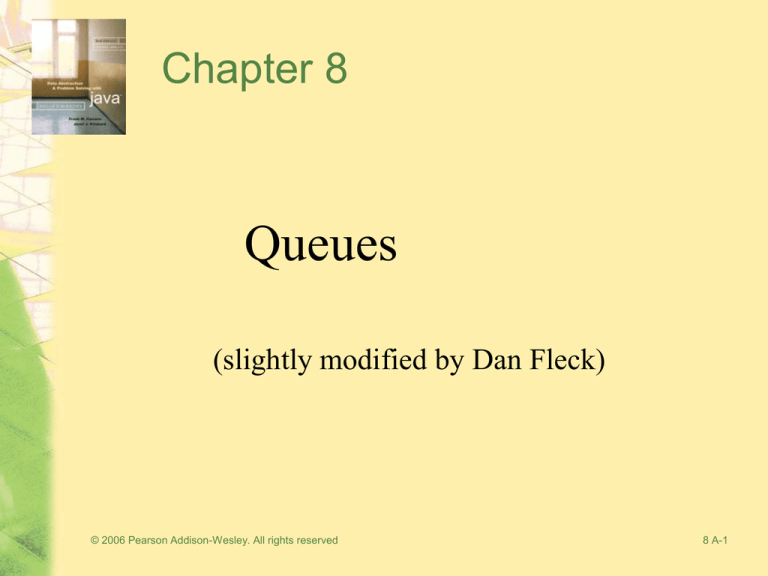
Chapter 8
Queues
(slightly modified by Dan Fleck)
© 2006 Pearson Addison-Wesley. All rights reserved
8 A-1
The Abstract Data Type Queue
• A queue
– New items enter at the back, or rear, of the queue
– Items leave from the front of the queue
– First-in, first-out (FIFO) property
• The first item inserted into a queue is the first item
to leave
• This is the same as waiting in a line. First person in
line gets served first.
© 2006 Pearson Addison-Wesley. All rights reserved
8 A-2
The Abstract Data Type Queue
• ADT queue operations
–
–
–
–
Create an empty queue
Determine whether a queue is empty
Add a new item to the queue
Remove from the queue the item that was added
earliest
– Remove all the items from the queue
– Retrieve from the queue the item that was added
earliest
© 2006 Pearson Addison-Wesley. All rights reserved
8 A-3
The Abstract Data Type Queue
• Queues
– Are appropriate for many real-world situations
• Example: A line to buy a movie ticket
– Have applications in computer science
• Example: A request to print a document
• A simulation
– A study to see how to reduce the wait involved in an
application
© 2006 Pearson Addison-Wesley. All rights reserved
8 A-4
The Abstract Data Type Queue
• Pseudocode for the ADT queue operations
createQueue()
// Creates an empty queue.
isEmpty()
// Determines whether a queue is empty
enqueue(newItem) throws QueueException
// Adds newItem at the back of a queue. Throws
// QueueException if the operation is not
// successful
© 2006 Pearson Addison-Wesley. All rights reserved
8 A-5
The Abstract Data Type Queue
• Pseudocode for the ADT queue operations
(Continued)
dequeue() throws QueueException
// Retrieves and removes the front of a queue.
// Throws QueueException if the operation is
// not successful.
dequeueAll()
// Removes all items from a queue
peek() throws QueueException
// Retrieves the front of a queue. Throws
// QueueException if the retrieval is not
// successful
© 2006 Pearson Addison-Wesley. All rights reserved
8 A-6
The Abstract Data Type Queue
Figure 8-2
Some queue operations
© 2006 Pearson Addison-Wesley. All rights reserved
8 A-7
Recognizing Palindromes
• A palindrome
– A string of characters that reads the same from left to
right as its does from right to left
• To recognize a palindrome, a queue can be used in
conjunction with a stack
– A stack can be used to reverse the order of occurrences
– A queue can be used to preserve the order of
occurrences
© 2006 Pearson Addison-Wesley. All rights reserved
8 A-8
Recognizing Palindromes
• A nonrecursive
recognition algorithm for
palindromes
– As you traverse the
character string from left to
right, insert each character
into both a queue and a
stack
– Compare the characters at
the front of the queue and
the top of the stack
Figure 8-3
The results of inserting a string
© 2006 Pearson Addison-Wesley. All rights reserved
into both a queue and a stack
8 A-9
Implementations of the ADT
Queue
• A queue can have either
– An array-based implementation
– A reference-based implementation
© 2006 Pearson Addison-Wesley. All rights reserved
8 A-10
A Reference-Based
Implementation
• Possible implementations of a queue
– A linear linked list with two external references
• A reference to the front
• A reference to the back
Figure 8-4a
A reference-based implementation of a queue: a) a linear linked list with two
external references
© 2006 Pearson Addison-Wesley. All rights reserved
8 A-11
A Reference-Based
Implementation
• Possible implementations of a queue (Continued)
– A circular linked list with one external reference
• A reference to the back
Figure 8-4b
A reference-based implementation of a queue: b) a circular linear linked list with one
external reference
© 2006 Pearson Addison-Wesley. All rights reserved
8 A-12
A Reference-Based
Implementation
Figure 8-5
Inserting an item into a nonempty queue
© 2006 Pearson Addison-Wesley. All rights reserved
8 A-13
A Reference-Based
Implementation
Figure 8-6
Inserting an item into an empty queue: a) before insertion; b) after insertion
© 2006 Pearson Addison-Wesley. All rights reserved
8 A-14
A Reference-Based
Implementation
Figure 8-7
Deleting an item from a queue of more than one item
© 2006 Pearson Addison-Wesley. All rights reserved
8 A-15
An Array-Based Implementation
Figure 8-8
a) A naive array-based implementation of a queue; b) rightward drift can cause the
queue to appear full
© 2006 Pearson Addison-Wesley. All rights reserved
8 A-16
An Array-Based Implementation
• A circular array
eliminates the
problem of
rightward drift
Figure 8-9
A circular implementation of a queue
© 2006 Pearson Addison-Wesley. All rights reserved
8 A-17
An Array-Based Implementation
Figure 8-10
The effect of some operations of the queue in Figure 8-8
© 2006 Pearson Addison-Wesley. All rights reserved
8 A-18
An Array-Based Implementation
• A problem with the circular array implementation
– front and back cannot be used to distinguish
between queue-full and queue-empty conditions
© 2006 Pearson Addison-Wesley. All rights reserved
8 A-19
An Array-Based Implementation
Figure 8-11a
a) front passes back when the queue becomes empty
© 2006 Pearson Addison-Wesley. All rights reserved
8 A-20
An Array-Based Implementation
Figure 8-11b
b) back catches up to front when the queue becomes full
© 2006 Pearson Addison-Wesley. All rights reserved
8 A-21
An Array-Based Implementation
• To detect queue-full and queue-empty conditions
– Keep a count of the queue items
• To initialize the queue, set
– front to 0
– back to MAX_QUEUE – 1
– count to 0
© 2006 Pearson Addison-Wesley. All rights reserved
8 A-22
So, how do I enqueue and
dequeue from a circular arraybased queue?
© 2006 Pearson Addison-Wesley. All rights reserved
8 A-23
An Array-Based Implementation
• Inserting into a queue
back = (back+1) % MAX_QUEUE;
items[back] = newItem;
++count;
• Deleting from a queue
front = (front+1) % MAX_QUEUE;
--count;
© 2006 Pearson Addison-Wesley. All rights reserved
8 A-24
Using a List (Vector or ArrayList)
How do I implement enqueue
and dequeue?
© 2006 Pearson Addison-Wesley. All rights reserved
8 A-25
An Implementation That Uses the
ADT List
• If the item in position 1 of a list list
represents the front of the queue, the
following implementations can be used
– dequeue()
list.remove(1)
– peek()
list.get(1)
© 2006 Pearson Addison-Wesley. All rights reserved
8 A-26
An Implementation That Uses the
ADT List
• If the item at the end of the list represents the back
of the queue, the following implementations can
be used
– enqueue(newItem)
list.add(list.size()+1, newItem)
Figure 8-13
An implementation that uses the ADT list
© 2006 Pearson Addison-Wesley. All rights reserved
8 A-27
The Java Collections Framework
Interface Queue
• JCF has a queue interface called Queue
• Derived from interface Collection
• Adds methods:
–
–
–
–
–
element: retrieves, but does not remove head
offer: inserts element into queue
peek: retrieves, but does not remove head
poll: retrieves and removes head
remove: retrieves and removes head
© 2006 Pearson Addison-Wesley. All rights reserved
8 A-28
A Summary of Position-Oriented
ADTs
• Position-oriented ADTs
– List
– Stack
– Queue
• Stacks and queues
– Only the end positions can be accessed
• Lists
– All positions can be accessed
© 2006 Pearson Addison-Wesley. All rights reserved
8 A-29
A Summary of Position-Oriented
ADTs
• Stacks and queues are very similar
– Operations of stacks and queues can be paired
off as
• createStack and createQueue
• Stack isEmpty and queue isEmpty
• push and enqueue
• pop and dequeue
• Stack peek and queue peek
© 2006 Pearson Addison-Wesley. All rights reserved
8 A-30
A Summary of Position-Oriented
ADTs
• ADT list operations generalize stack and
queue operations
– length
– add
– remove
– get
© 2006 Pearson Addison-Wesley. All rights reserved
8 A-31
Application: Simulation
• Simulation
– A technique for modeling the behavior of both
natural and human-made systems
– Goal
• Generate statistics that summarize the performance
of an existing system
• Predict the performance of a proposed system
– Example
• A simulation of the behavior of a bank
© 2006 Pearson Addison-Wesley. All rights reserved
8 A-32
Application: Simulation
Figure 8-14a and 8-14b
A blank line at at time a) 0; b) 12
© 2006 Pearson Addison-Wesley. All rights reserved
8 A-33
Application: Simulation
Figure 8-14c and 8-14d
A blank line at at time c) 20; d) 38
© 2006 Pearson Addison-Wesley. All rights reserved
8 A-34
Application: Simulation
• An event-driven simulation
– Simulated time is advanced to the time of the next event
– Events are generated by a mathematical model that is
based on statistics and probability
• A time-driven simulation
– Simulated time is advanced by a single time unit
– The time of an event, such as an arrival or departure, is
determined randomly and compared with a simulated
clock
© 2006 Pearson Addison-Wesley. All rights reserved
8 A-35
Application: Simulation
• How many tellers do I need to ensure waiting time
is less than 5 mins per customer. Assuming our
busiest time is customers arriving 1 per 3 minutes?
• The bank simulation is concerned with
– Arrival events
• Indicate the arrival at the bank of a new customer
• External events: the input file specifies the times at which the
arrival events occur
– Departure events
• Indicate the departure from the bank of a customer who has
completed a transaction
• Internal events: the simulation determines the times at which
the departure events occur
© 2006 Pearson Addison-Wesley. All rights reserved
8 A-36
Summary
• The definition of the queue operations gives the ADT
queue first-in, first-out (FIFO) behavior
• A reference-based implementation of a queue uses either
– A circular linked list
– A linear linked list with a head reference and a tail reference
• An array-based implementation of a queue is prone to
rightward drift
– A circular array eliminates the problem of rightward drift
© 2006 Pearson Addison-Wesley. All rights reserved
8 A-37
Summary
• To distinguish between the queue-full and queueempty conditions in a queue implementation that
uses a circular array, you can
– Count the number of items in the queue
– Use a full flag
– Leave one array location empty
• Models of real-world systems often use queues
– The event-driven simulation in this chapter uses a
queue to model a line of customers in a bank
© 2006 Pearson Addison-Wesley. All rights reserved
8 A-38
Summary
• Simulations
– Central to a simulation is the notion of
simulated time
• In a time-driven simulation
– Simulated time is advanced by a single time unit
• In an event-driven simulation
– Simulated time is advanced to the time of the next event
– To implement an event-driven simulation, you
maintain an event list that contains events that
have not yet occurred
© 2006 Pearson Addison-Wesley. All rights reserved
8 A-39







